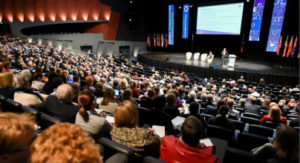Roundtable Discussion on the Role and Efficacy of PSAs
Increasingly PSAs are being used to educate the public about a wide variety of health issues, ranging from AIDS to smoking. To discuss the role and future of health-related public service advertising messages, forty-one health communications practitioners from the federal government and private sector met on the campus of the National Institutes of Health.
Following is a summary of the one-day meeting at which attendees discussed the current PSA environment, new proposals for paid airtime and a look at future options for health communicators.
PSA Environment
Because of increased influx of PSAs and market forces combined with fewer federal regulations ruling broadcasters’ programming decisions, PSA time is declining. However, studies differ in their findings on the amount of air time available.
In the 1970s, the Federal Communications Commission began abolishing the regulations aimed at providing an adequate amount of public interest programming. The Commission now requires only a “general obligation” that broadcasters address issues of concern to their communities.
The FCC also eliminated the rule which limited broadcasters to 16 minutes of commercials per hour. They are now free to air any number of minutes of commercials.
Economic forces now determine if stations will run PSAs.
Although never strongly enforced, the Fairness Doctrine, until its death in 1987, required broadcasters to devote a reasonable amount of broadcast time to coverage of important controversial public issues, including contrasting points of view. This doctrine was responsible for the anti-smoking advertising campaigns in the late 1960s. In contrast, economic forces now determine if stations will run PSAs.
 Statistics indicate that the volume of PSAs sent to TV stations is increasing with the number of PSAs sent to the major networks increasing by 40%.
Statistics indicate that the volume of PSAs sent to TV stations is increasing with the number of PSAs sent to the major networks increasing by 40%.
CBS network reported receiving over 5,500 storyboards in a single year.
Even though there are fewer PSAs running on each station, there are a greater number of stations on which to get airtime largely due to the fact that when the nation converted to digital broadcasting each TV station got six sub-channels, many of which use PSAs.
Impediments to PSA Usage
One impediment to PSA usage is a disconnect between the level of importance placed on a health problem by society and the media. A statewide survey of media gatekeepers in Texas showed there was little correlation between what the gatekeeper considered to be an important health problem and the actual magnitude of the health problem. We can’t assume the media places the same priorities on health messages that we do, so we need to educate on the true scope of any particular health problem.
 Various studies have been conducted to survey the media on why they do not use PSAs as shown in the graph.
Various studies have been conducted to survey the media on why they do not use PSAs as shown in the graph.
In another survey a majority of respondents said the quality of the materials in the appropriate format is very important, but the most important factor in determining whether a campaign is aired is the credibility of the source.
How is the Campaign Measured?
When the public and private sectors join together to launch a public education campaign, they have the option of buying broadcast airtime. That permits quantitatively measuring success through product sales, or other feedback. Since most government agencies are precluded from buying airtime, indicators of PSA effectiveness is a greater challenge.
Most public health service agencies track Nielsen data, bounceback cards and response to call-ins or write-ins. However, many stations do not take the time to return bounce back cards. Most public health agencies supplement these sources with other indicators of PSA usage, such as public requests for information mentioned in PSA materials and website visits.
Few campaigns have been examined to determine effectiveness over time, with most evaluations focusing upon a specific PSA.
What Factors Contribute to Greater PSA Use?
Participants who had successfully launched PSA campaigns shared their experiences and specific tips on getting the attention of public service directors. Their findings included:
- Stations prefer one health issue per release and locally tagged spots.
- Personal delivery has an impact and may increase the chance of play. Visiting stations directly is difficult, but well worth it.
- Photoboards are a must for TV, since station public service directors have little time to view tapes.
- If a spot has a tag encouraging the public to write for a free booklet,” be sure to have an adequate supply of the booklets to fulfill requests.
- The main criteria for playing a spot is local impact. The more localized the health problem, the better.
- Quality execution is crucial.
- Stations do seek out opportunities for community service (health screenings, health fairs, fund raisers, special call-in shows.)
- Tying a campaign in with another medium is often very effective, (i.e. healthy heart newspaper quiz) in getting the message to the intended audience. A tiein with a news event also may increase play.
- The use of premiums, hooks, lunch, plaques, awards and other incentives (formal recognition, follow-up letters of appreciation) can be instrumental in building a relationship with the public service director.
- Consider networks as marketing targets and the public service directors as target audiences. Investigate issues/pressures the public service director faces from “upstairs.”
Recommendations for Future Action
- Continue to share information among organizations that produce and distribute PSAs.
- Continue to document the PSA environment, i.e. understanding gatekeepers; develop better methods of monitoring; study the impact of buying airtime on PSAs.
- Share information and concerns with media through their trade and professional organizations.
- Establish criteria to answer: when is a campaign successful; what are the priority messages, and what should trigger purchase of media time?
- Form and foster public debate at the federal, state and local levels by using opinion polls to bolster positions or earmarking a proportion of excise taxes on tobacco and alcohol such as the state of Minnesota has done, to support public education campaigns.
- Systematize activities for meetings such as this one – build larger audiences and look for additional sources of money to fund activities. Consider forming a “Public Service Council” to monitor government public service interests.
- Look ahead – seek out new mass media channels for messages such as placebased media (physician’s offices), national cable networks, and the internet.







Leave A Comment